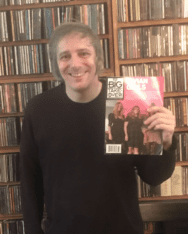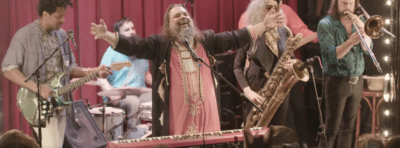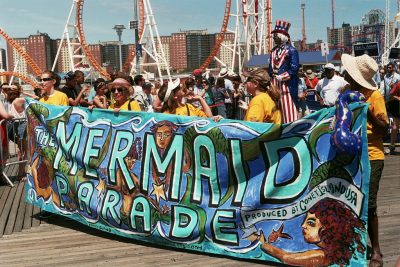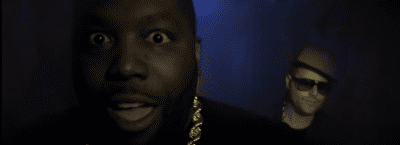Courtesy The Big Takeover
America’s longest-running underground music magazine is based in … Park Slope?
Punk journalism godfather Jack Rabid moved The Big Takeover to Brooklyn 20 years ago and hasn’t looked back (except for this article)
Jack Rabid, the publisher of America’s longest continually-running underground music publication, The Big Takeover, is guiding me into the guts of his editorial legacy. We had been chatting for an hour on the middle floor of his family’s brownstone, within spitting distance of Fifth Avenue in central Park Slope. And now we are outside, descending through the metal-hatch cellar doors adjacent to the stoop, ducking our heads and safely navigating a few precarious steps into the basement.
It doesn’t take long to conclude that Rabid’s basement could be the punk and indie wing for a national music archive, with thousands of Big Takeover magazines in boxes and containers. Every single issue of the semiannual magazine — 91 in total — is down there and will soon be joined by copies of No. 92, which is out this month.
Looking around the cellar, I ask him for his favorite story, cover or interview.
“I’ve had REM on the cover in three different decades,” Rabid says. “I really liked interviewing Brian Wilson of the Beach Boys at his home in Bel-Air. Probably my favorite two interviews were Eric Idle of Monty Python and Ray Davies of The Kinks. Ray’s publicist said, ‘He’s got to go now and be on MTV.’ And he was like, ‘I’m pretty sure I got 10 more minutes, and I want to spend it here.’”
But before he started earning one-on-one time with music and cultural icons in the early 1980s, Rabid worked in the mail room for a shipping company in the World Trade Center. He would sneak in on weekends — hardly anyone else was around — to use his employer’s Xerox 8200 copy machine. There, he would assemble some of the earliest issues of The Big Takeover with tape and scissors. This was well before the era when there was a Kinko’s in every neighborhood for punk kids to piece together their ’zines and show flyers.
“I’d be the only person in the office that would have 250 people in it on weekdays, and, boy, would that building creak,” Rabid remembers. “With all the other machines shut down in an empty office building, you could hear that [tower] sway back and forth. It would give me the freaking willies. I would be like, ‘I got to work a little faster.’ I got pretty damned good with that Xerox.”
Every other national underground music publication that came before 1980 is gone. Creem, founded in 1969, shut down in 1989 before relaunching last year. SPIN, which isn’t as old as Big Takeover, doesn’t print a magazine these days. Most national underground music publications from the past now only exist online, such as SPIN and Magnet Magazine.
There were still many tape-and-scissors days ahead before his tech game was upgraded. But 40 years later, he’s still working on The Big Takeover, which has 6,000 subscribers in 45 countries and all 50 states.
Rabid and his wife, Mary Greenfield, moved to Park Slope 20 years ago from Eldridge Street in the Lower East Side, where he had spent the prior two decades running the magazine and playing in punk bands. It was downtown in the ‘80s and ‘90s — an iconic time and place to make a scene that gave the world legends such as The Ramones, Madonna, Blondie and Television.
“I never thought you’d get me out of there with a crowbar because Manhattan is the action,” says Rabid.

Rabid at home
Corradi is a punk
When it comes to underground music, you’d be hard-pressed to find another Brooklyn dweller whose life is as end-to-end intertwined with the genre’s history as Rabid’s.
He grew up in Summit, New Jersey, on Harvey Drive in a house a half-mile from The Velvet Underground’s first show at Summit High School in December 1965. As the groundbreaking band — then composed of singer/guitarist Lou Reed, multi-instrumentalist John Cale, guitarist Sterling Morrison, and drummer Angus MacLise — played their debut set, Rabid was 3 years old and only known by the name on his birth certificate, Jack Corradi.
“I became such a massive punk rocker in the late 1970s that I’ve wondered if there was some weird osmosis going on,” Rabid says. “It’s like Lou Reed went down Kent Place Boulevard, took a right on Passaic, a left on Harvey Drive, and hit me in my playpen.”
His interest in punk was sparked during high school when he discovered Californian punk publications No Magazine, Slash, Flipside, and Search & Destroy. From his childhood home, he and his friend Dave Stein then created The Big Takeover, which, at its genesis, was a fanzine dedicated to New York punk pioneers, The Stimulators. (Stein quit after one issue.) Alongside the ‘zine, Rabid helped start what came to be an influential NYC punk band, Even Worse, as its drummer. After graduating high school in 1980, he planted flags for The Big Takeover and Even Worse in Manhattan where they grew in stature.
It wasn’t long before he met the future Sonic Youth luminary, guitarist and singer Thurston Moore, who for a stint filled in on guitar for Even Worse, which played with The Stimulators and game-changing D.C. bands Bad Brains and Minor Threat. (The Big Takeover was named after a Bad Brains tune.) Moore, who lived nearby on Eldridge Street, says he was an avid reader of The Big Takeover and impressed by Rabid’s vast collection of records, zines, and demo tapes from “every hardcore band in the scene.”
“I knew this guy was in it for the long run,” Moore wrote in an email to Brooklyn Magazine. “Jack was never too keen on the experimental noise world I was so engaged with, but he always had a bemused respect for anyone’s interest in music regardless of genre — he knew it was all about dynamism. For Sonic Youth to eventually grace the cover of The Big Takeover was one of the coolest things — for me certainly! — to happen with Sonic Youth.”
Prospects by the park
Part of the reason Rabid and his family chose Park Slope over other New York City locales was that he had played league softball in Prospect Park for years before, and he was familiar with the neighborhood. One of his softball opponents in the 2000s was Anselmo Huggins. Beyond observing each other’s line drives, pop-ups and put-outs on the field of play, they didn’t really get to know each other until they met at the former neighborhood staple Dizzy’s Diner, where Huggins waited tables. One day while working in 2007, Huggins began playing the obscure Austin, Texas-based indie band Voxtrot for patrons.
Rabid’s ears perked up, and he said to the waiter, “Oh, you’re one of us!”
Huggins, who has written for The Big Takeover ever since, explains the publication’s staying power this way: “The ads are about the music. The writers are about the music, and the readers just want to read about the music. It’s also a magazine funded by subscribers, artists, and labels. So it feels like it’s yours.”
Later this month, Rabid will ship back issues of The Big Takeover as part of a charity auction for The Cold Spring School in New Haven, Conn., where Huggins sends his grade-school son. It was Huggins’ idea.
“He’s always been great to me, but I never assumed that he would say yes,” the former waiter says. “And [I] was surprised when he did.”
In some ways, Rabid has always been paying back (and paying it forward). In his Manhattan days, Rabid moonlighted his music criticism writing and other punk-minded stories for Interview, Spin, Creem, Alternative Press, The Village Voice, Paper, and other music/culture pubs. Things were happening for the scribe because of The Big Takeover’s growing influence, and he once found himself interviewing Joe Strummer, the legendary frontman of The Clash, at The Broome Street Bar before the late singer insisted on picking up the tab—yet Rabid wasn’t about to give in.
“Finally, I told him that there’d be no Big Takeover without The Clash,” Rabid says. “He said, ‘OK, you got me there.’”
Life was good in Gotham.
But Rabid and his wife planned to have a family and needed room for kids (they now have a son and a daughter), and two decades ago, they found their home. He kept The Big Takeover’s office in Manhattan for three more years before moving operations in 2006 to his family’s Brooklyn brownstone, where Rabid pens one-third of the articles for every edition and proofreads the whole magazine.
“Sometimes I work in the kitchen, sometimes in the living room — it’s like I’m the ‘Cat in the Hat’ or something,’” he says, chuckling. “The laptop lets me do those things.”
Seems like a step up from his Xerox 8200 days. Now, he’s using today’s technology to communicate with his art director in Oakland, Ca., as they put the finishing touches on No. 92 this week from opposite ends of the country. When subscribers find the issue in their mailbox later this month, they’ll see the Canadian band Sloan — one of the best groups of the last three decades, Rabid says — on the cover.
“The emotion of finishing an issue is one of tremendous relief and a small bit of euphoria because it’s a four-month project and the last month really consumes my life,” he says. “I used to have a shot of bourbon with my [Bay Area] friends at the Latin American Club every time one wrapped, as I was always out there [finishing the magazine] with my art director. Nowadays, we do it by Zoom, me in Brooklyn, him in Oakland.”
You might also like 


























